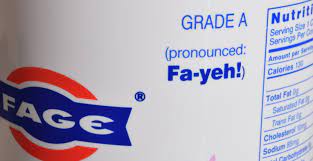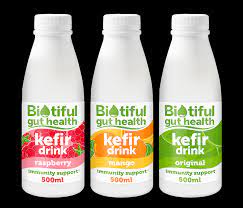Language should help us to communicate. To understand. To navigate.
Every industry, sector and category have their own language.
We often expect others to learn the language of our sector. Even potential customers who we want to buy from us!
And sometimes we’re just too close to see that the language we’re using is unknown (and not understood), misinterpreted, too technical or simply difficult to pronounce.
And that’s before we get into differences between English, Spanish, French...or even UK English vs. American English.
If we want others to engage with our brand or products then we need to recognise these barriers, and then find solutions.
Say what?

Nobody likes to feel stupid. Yet having a brand or product name that people are unsure how to pronounce poses that risk. People will avoid saying it for risk of looking silly. And a brand that nobody talks about is tricky!
Let’s talk about the Greek yoghurt brand Fage. You're already thinking how do I pronounce this?!
Conducting group discussions a few years ago, none of the participants were confident in how to pronounce the brand.
They would refer to it as the one beginning with F. They would mumble something, so as not to be heard getting it wrong. They would refer to it as ‘Fay-dge or something like that’. They would look embarrassed. Questioning. Hopeful – that they’d got it right.
Luckily the brand took this challenge on board. They didn't change the name. They simply added ‘Pronounced: Fa-yeh!’ on the pack.
It recognises the challenge. Provides a solution. And does so in a lighthearted way so nobody feels stupid.
It was the same when quinoa was first introduced. People didn’t know how to pronounce it. And after not too long it was followed by keen-wah in brackets to help with pronunciation (and adoption).
Sounds familiar

Other words may feel familiar, yet the context in which they’re used can lead to misinterpretation.
The words stocks, funds, and shares don’t feel particularly challenging.
We use these words in a variety of contexts. Stock taking. Fund raising. Having the funds to buy something. My share of the prize!
Yet, in the context of finance, many people would struggle to explain what each of these terms means. Suddenly these simple words take on different meanings. It’s estimated that around three quarters of people in the UK don’t understand ‘basic’ financial terms. And that’s before you get into derivatives or hedging!
Within food and drink, again simple words can cause confusion. Avocado pear. Coconut water.
Hopefully nowadays most people wouldn’t assume that an avocado is simply another variety of pear! Yet when they were introduced to the UK in the 1960s, this did happen. Avocado and custard! Yuck!
And Coconut water, despite its name is not the same as water. Nor is it water with a coconut flavour.
And for any non-Brits in case you’re wondering, Toad in the Hole does not contain toads. It’s sausages in Yorkshire Pudding. And no, Yorkshire Pudding is not a dessert either!
In contrast, the term craft has done a fantastic job of conveying a variety of attributes when it comes to food and drink. And has transposed well across categories.
Craft beer. Craft gin. Craft bakery.
It indicates skill and knowledge. It suggests care and attention. It signifies small producers.
These associations in turn suggest ethical, sustainable practices.
Choosing the right words and descriptors is critical.
Kom what? Pro what?

Having talked about familiar words but in a different context, what about unfamiliar words?
Within food and drink words like Kombucha and Kefir are very much on trend. But until recently most people did not know what they were. And the words gave no clues as to what they were. People had to be educated. But with no preconceptions about what these products were, at least this knowledge sharing started from a clean sheet.
Describing them as good or friendly bacteria was sufficient for many to buy into to the gut health trend.
Messaging needs to be simple, focus on the benefit and be communicated before point of purchase.

